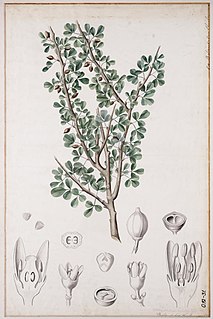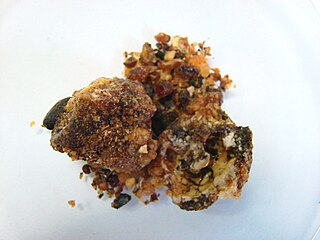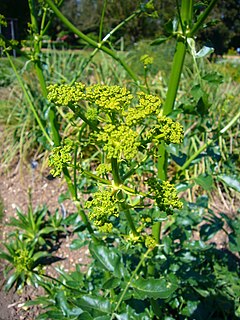Literature
- L'Opoponax , the 1964 novel in French by Monique Wittig
Opopanax ("the juice of all-heal") can refer to:

In polymer chemistry and materials science, resin is a solid or highly viscous substance of plant or synthetic origin that is typically convertible into polymers. Resins are usually mixtures of organic compounds. This article focuses on naturally occurring resins.

Myrrh is a gum-resin extracted from a number of small, thorny tree species of the genus Commiphora. Myrrh resin has been used throughout history as a perfume, incense and medicine. Myrrh mixed with posca or wine was common across ancient cultures, for general pleasure, and as an analgesic.

Balsam is the resinous exudate which forms on certain kinds of trees and shrubs. Balsam owes its name to the biblical Balm of Gilead.

Opopanax chironium, common name Hercules' all-heal, is a herb of the family Apiaceae.

The Burseraceae are a moderate-sized family of 17-19 genera and about 540 species of flowering plants. The actual numbers differ according to the time period in which a given source is written describing this family. The Burseraceae are also known as the torchwood family, the frankincense and myrrh family, or simply the incense tree family. The family includes both trees and shrubs, and is native to tropical regions of Africa, Asia. Australasia, and the Americas.

Bdellium, also bdellion, is a semi-transparent oleo-gum resin extracted from Commiphora wightii of India and from Commiphora africana trees growing in Somalia, Ethiopia, Eritrea and sub-saharan Africa. According to Pliny the best quality came from Bactria. Other named sources for the resin are India, Arabia, Media, and Babylon.

The genus of the myrrhs, Commiphora, is the most species-rich genus of flowering plants in the frankincense and myrrh family, Burseraceae. The genus contains approximately 190 species of shrubs and trees, which are distributed throughout the (sub-) tropical regions of Africa, the western Indian Ocean islands, the Arabian Peninsula, India, and Vietnam. The genus is drought-tolerant and common throughout the xerophytic scrub, seasonally dry tropical forests, and woodlands of these regions.

Commiphora wightii, with common names Indian bdellium-tree, gugal, guggul, gugul, or mukul myrrh tree, is a flowering plant in the family Burseraceae, which produces a fragrant resin called gugal, guggul or gugul, that is used in incense and vedic medicine. The species is native to southern Pakistan and western India. It prefers arid and semi-arid climates and is tolerant of poor soil.
The Balm of Gilead was a rare perfume of the Bible, now used in figurative speech to signify a universal cure.

Commiphora myrrha, called myrrh, African myrrh, herabol myrrh, Somali myrrhor, common myrrh, or gum myrrh is a tree in the Burseraceae family. It is one of the primary trees used in the production of myrrh, a resin made from dried tree sap. The tree is native to the Arabian peninsula and to Africa. It is called 'mur' (المر) in Arabic, meaning bitter. It is the gum of the myrrh tree. Its oil is called oleoresin. It famously comes from Mecca, so it is called 'Mur Makki'.

Commiphora gileadensis, the Arabian balsam tree, is a shrub species in the genus Commiphora growing in Saudi Arabia, Yemen, southern Oman, Sudan and in southeast Egypt where it may have been introduced. Other common names for the plant include balm of Gilead and Mecca myrrh, but this is due to historical confusion between several plants and the historically important expensive perfumes and drugs obtained from them. True balm of Gilead was very rare, and appears to have been produced from the unrelated tree Pistacia lentiscus. This species also used to include Commiphora foliacea however it was identified and described as a separate species

Boswellia papyrifera, also known as Sudanese frankincense, is a species of flowering plant and frankincense that is native to Ethiopia, Eritrea and Sudan. The tree is cultivated in Ethiopia because of its valuable resin. The incense smoke is characterized by a fresh lemon-pine scent, and is therefore highly esteemed. In Ethiopia where it is called itan zaf, it comes in semi-translucent yellow tears. The gum resin of Boswellia papyrifera coming from Ethiopia, Sudan and E. Africa is believed to be the main source of frankincense of antiquity.

Stacte and nataph are names used for one component of the Solomon's Temple incense, the Ketoret, specified in the Book of Exodus. Variously translated to the Greek term or to an unspecified "gum resin" or similar, it was to be mixed in equal parts with onycha, galbanum and mixed with pure frankincense and they were to "beat some of it very small" for burning on the altar of the tabernacle.
Commiphora africana, commonly called African myrrh, is a small deciduous tree belonging to the Burseraceae, a family akin to the Anacardiaceae, occurring widely over sub-Saharan Africa in Angola, Botswana, Burkina Faso, Chad, Eritrea, Ethiopia, Kenya, Mali, Mauritania, Mozambique, Namibia, Niger, Senegal, Somalia, South Africa, Sudan, Swaziland, Tanzania, Uganda, Zambia and Zimbabwe. On sandy soils this species sometimes forms pure stands, deserving consideration as a plant community or association.

Curzerene is a volatile, aromatic terpenoid found in many herbs and spices, such as Curcuma zeodaria. It is bioactive isolate of Caribbean corals and is also found in myrrh. More specifically it has been found to make up a significant portion - 12.97% - of the smoke produced from burning Commiphora myrrha oleo gum resin. It is also a major component of myrrh oil, which has been shown in vitro to possess anti-inflammatory properties at sub-toxic by inhibiting the production of the inflammatory cytokine IL-6 by human gingival fibroblasts. Anecdotal evidence exists to support the anti-inflammatory effect of myrrh oil.

Opopanax is the commercial name of bisabol or bissabol, the fragrant oleo-gum-resin of Commiphora guidottii. It has been a major export article from Somalia since ancient times, and is called hebbakhade, habaghadi or habak hadi in Somali. It is an important ingredient in perfumery and therefore known as scented myrrh, sweet myrrh, perfumed myrrh or perfumed bdellium.

Opopanax is a genus of plants in the family Apiaceae.

The Indian Institute of Natural Resins and Gums, formerly known as the Indian Lac Research Institute, is an autonomous institute, established under the umbrella of Indian Council of Agricultural Research (ICAR) by the Ministry of Agriculture, Government of India for advanced research on lac and other natural resins and gums. The Institute is located at Namkum, Ranchi in Jharkhand, India.
Myrrh is a natural gum or resin extracted from a number of small, thorny tree species of the genus Commiphora.
Commiphora guidottii, commonly known as scented myrrh, is a tree or shrub species that is native to the countries of Somalia and Ethiopia. Essential oil from its gum-resin has been researched for its use in topical treatment of wounds.